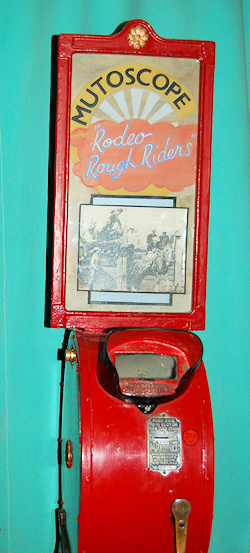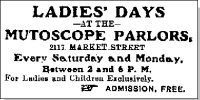Mutoscope
In the 1890s, something like a technological gold rush took place to find a practical way of presenting moving pictures. In the US, for example, Edison demonstrated his kinetoscope in 1894. Alongside considerable mechanical ingenuity lay great linguistic creativity, as a little squib that appeared in the Chicago Record in early 1898 will demonstrate:
The single invention of throwing moving pictures on screen, variously known as the vitascope or kinetoscope, has added dozens of new words to the language within the last year or two. Here is a list of the various names for “movement photography:” Phantoscope, criterioscope, vitascope, cinematograph, biograph, kinematograph, wonderscope, animatoscope, vitagraph, panoramograph, cosmoscope, anarithmoscope, katoptikum, magniscope, zoeoptrotrope, variscope, phantasmagoria, projectoscope, cinograph, hypnoscope, centograph, X-ograph, electroscope, cinegraphoscope, craboscope, vitaletiscope, cinematoscope, mutoscope, cinoscope, animaloscope, theatograph, chronophotographoscope, cinnomonograph, motograph, kinetograph, rayoscope, motorscope, kinetiphone, thromotrope, phenakistoscope, venetrope, vitrescope, zinematograph, vitopticon, stinnetiscope, vivrescope, diaramiscope, lobsterscope, corminograph, kineoptoscope or any other old scope.

A restored mutoscope
at Wookey Hole,
Somerset
Lobsterscope? Craboscope? Was this some joke of the writer’s? Buried in that list was one that was certainly real, mutoscope, a device created by the American inventor Herman Casler and patented in 1894. The word is assumed to be from Latin mutare, to change.
Both the kinetoscope and the mutoscope required the viewer to peer into a viewing slot while turning a handle. But whereas Edison’s device used a strip of film, Casler’s was very close in idea to the flip-book, in which riffling through a sequence of still pictures seems to create a moving image. In the mutoscope the pictures were arranged around a drum; turning a handle caused them to appear one after the other at about 16 frames a second, the minimum needed to give an illusion of movement.
The big problem with both the kinetoscope and the mutoscope was that only one person could watch at a time. The promoters of the mutoscope, the KMCD Syndicate, tried to get around the issue by introducing Mutoscope parlours that housed several such machines. An example was reported in the Newark Daily Advocate in May 1900: “One of the new features of the park this season is a mutoscope parlor adjoining the bowling alleys. About 20 machines will be put in this parlor at the start.”

This advertisement appeared in the Daily News of Galveston, Texas, in January 1903
But there was no way the machines could compete with the much more social and comfortable environment of a seated audience watching projected film. The Syndicate soon accepted this and introduced the Biograph, which enjoyed much greater success.
Many people remember the mutoscope in the form of the very mildly risqué What the Butler Saw machines, once commonly to be found on British seaside piers and in amusement arcades.

